Huawei P8 smartphone: A thin and light flagship with novel features
Overview
Huawei's Ascend P series has been the company's flagship smartphone since the Ascend P1 was launched in 2012. Since then, we've seen steady yearly improvement from the Ascend P2, Ascend P6 (Huawei decided to skip the Ascend P3-5) and last year's Ascend P7. However, despite much improvement, Huawei's flagship phones haven't quite been able to compete with the best of the best, and have often been let down by disappointing benchmark performance and average image processing.
This year, Huawei hopes that will all change with the newly announced Huawei P8 (they're dropping the "Ascend" part of the name). The P8 boasts an ultra-thin, one-piece full aluminum design, an in-house designed octa-core 64-bit Kirin 930 processor that Huawei says is 80 percent faster than last year's P7, a 5.2-inch Full HD display with ultra thin bezels, giving it a very high 78.3 percent body-to-screen ratio, and a 13-megapixel camera with the world's first four-color RGBW sensor, 1.2-degree optical image stabilization and DSLR-level independent image processor.
But as we know, impressive specs aren't everything. Will the P8 finally let Huawei take a seat at the big boys' table alongside the likes of Apple, Samsung, LG, Sony and HTC? Let's find out.
The P8 will be available in early June, and will be available in a Standard version with 3GB RAM and 16GB internal storage for €499 (~S$722), or a premium version with 64GB internal storage for €599 (~S$868). It's worth noting that both versions of the P8 support expandable microSD storage up to 128GB (but you'll have to give up one of the Nano-SIM slots to use it - yes, it has dual SIM support).
And if phablet-sized smartphones are more your thing, look out for the 6.8-inch (yes, you read that right) P8 Max, which is due out later this year.
|
|
|
|
|
|
|
|
|
|
Design
The P8 is super slim. In fact, at just 6.4mm it's one of the thinnest phones out there. Best of all, unlike the iPhone 6 and Samsung Galaxy S6, it's completely flat, with its camera bump sitting flush with the rear of the device. Compared to last year's P7, the P8 looks a bit more squarish, with the curved edge along the bottom of the P7 now gone.
On the front of the phone, razer thin bezels have allowed Huawei to pack a 5.2-inch Full HD display into a pretty compact-sized phone, and the P8 actually boasts one of the best screen to body ratios around, at 78.3 percent (for reference, the front of the iPhone 6 is only 65.8 percent, and the front of the Samsung S6 is 70.8 percent). The display is topped with Gorilla Glass 4, and Huawei has also given it a nano-coating to protect it from liquids spilling on top of it.
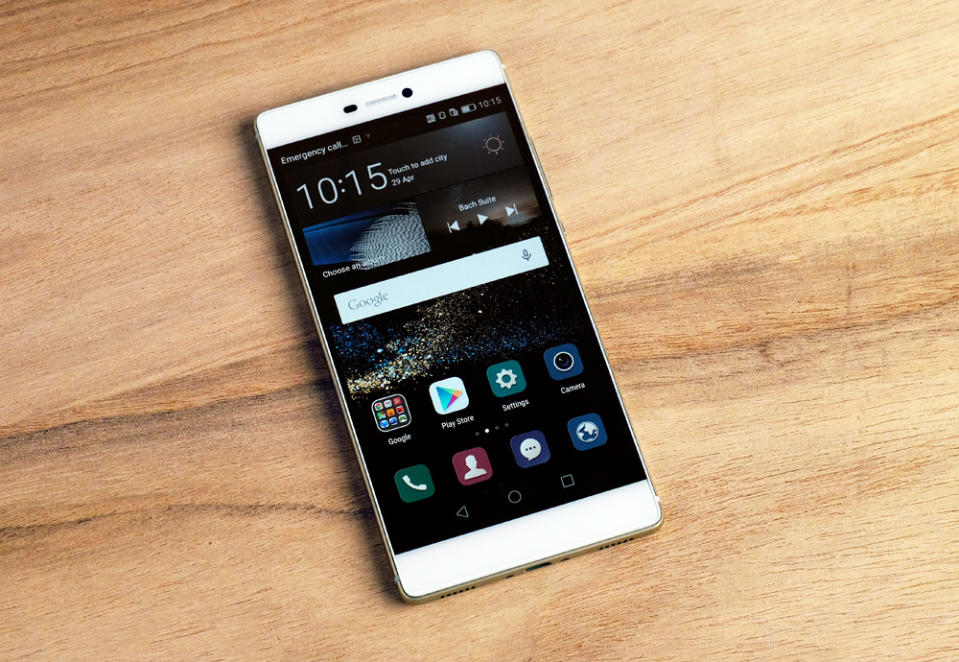
The square design is echoed in the interesting squarish power button, which can be found on the right-side of the phone. Over here, you'll also find the volume rocker and slots for the nano SIM card and microSD card slots (which also doubles up as a second nano SIM card slot).
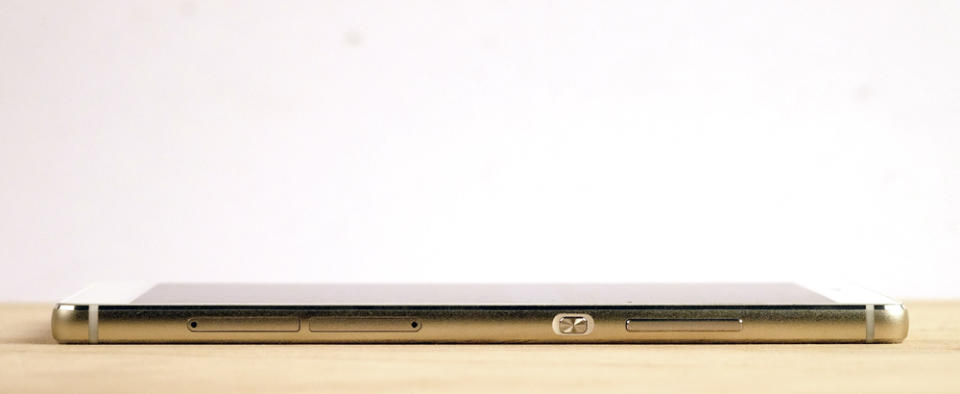
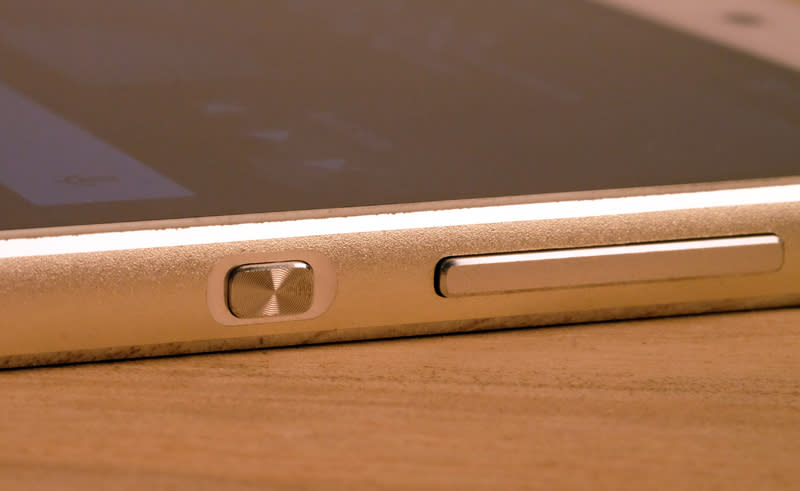
Despite the more squarish look of this year's P8, the frame of the phone isn't entirely flat; it's slightly rounded, although the curve is far less pronounced than the ones found on the iPhone 6. It's actually just enough to make the phone comfortable to grip, without being too slippery.
On the bottom of the phone, you'll find the micro-USB port and the P8's dual speakers. Huawei has put some effort into making the P8 a decent audio player, and it boasts an on board Hi6402 DSP for improved audio quality.
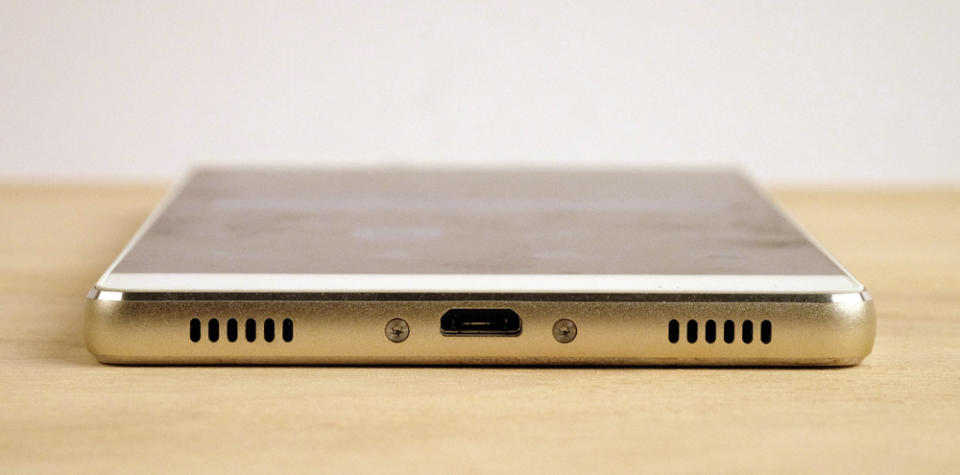
The phone will be available in four colors: carbon black, titanium gray, mystic champagne and prestige gold. The prestige gold appears to be a much more ostentatious gold color, while the mystic champagne is more subdued.
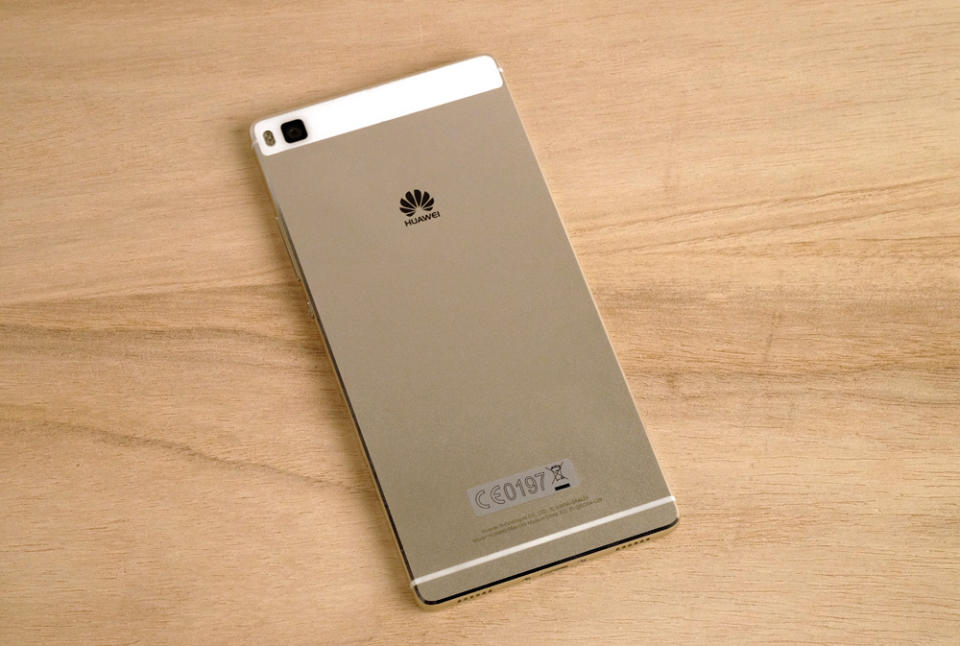
On the Mystic Champagne color variant, the antenna lines and camera module bar are white, whereas they're black on every other color:
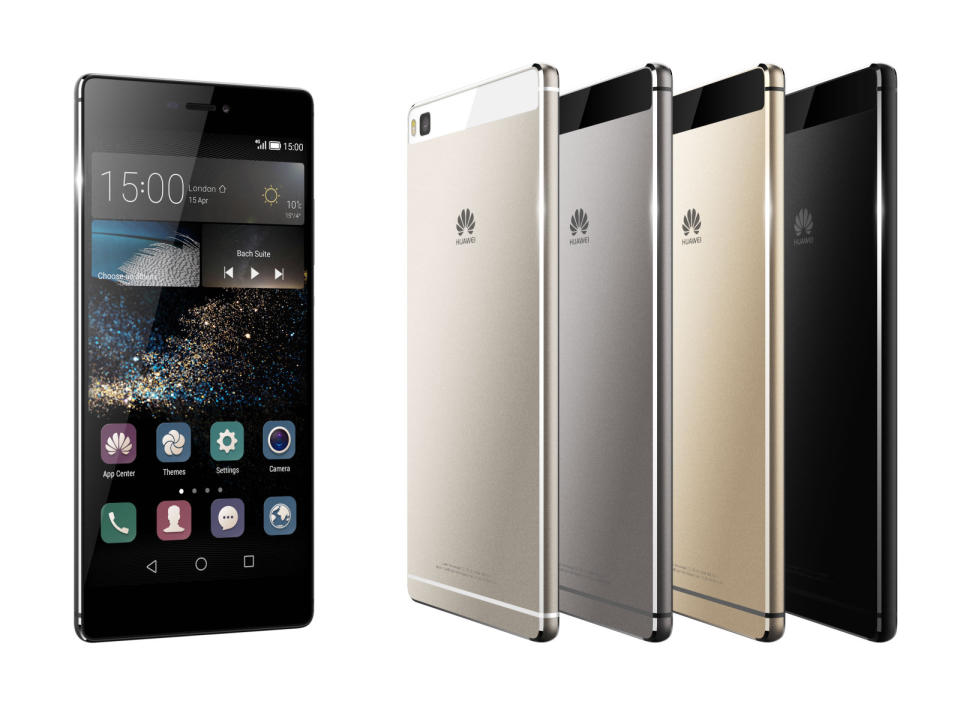
Display & Audio
The P8 is armed with a 5.2-inch Full HD 1920 x 1080 pixel resolution IPS-LCD display, giving it 424 ppi, which actually gives it a slightly lower ppi count than its smaller-screened predecessor, the 5-inch P7 (445ppi). Nevertheless, picture quality is still very crisp, with vivid colors, and excellent viewing angles. Contrast could perhaps be slightly better, and the blacks aren't as deep as they could be, appearing slightly bluish with the lights off, but this is a problem shared by all LCD displays.
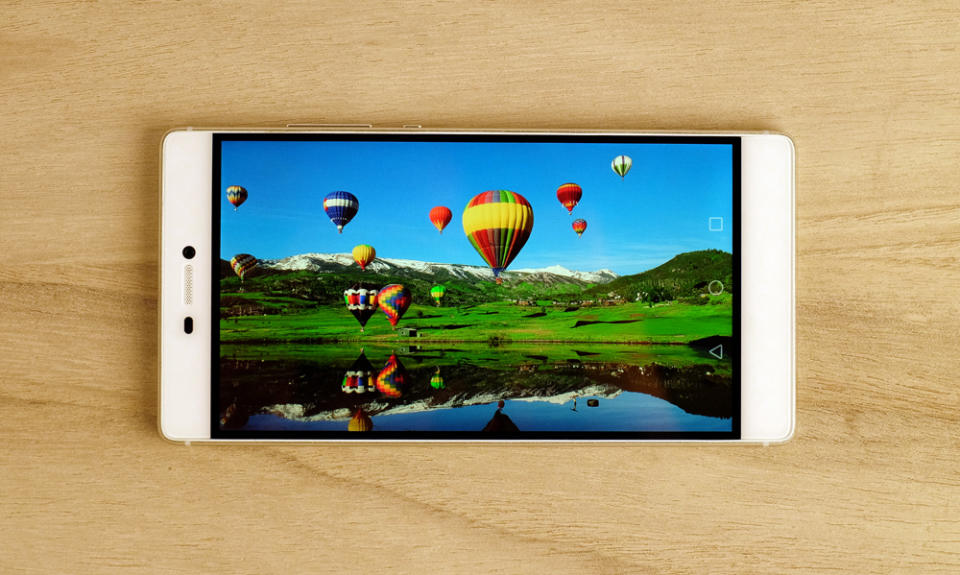
Audio on the P8 is supplied via two speakers located at the bottom edge. Audio quality was reasonable, and the P8 was quite loud too, but honestly we were expecting a bit more from the on-board Hi6402 DSP.
UI Features
The P8 runs on Android 5.0 Lollipop with Huawei's EMUI 3.1 running over the top of it. As with many China-brand smartphones, the UI removes the app drawer in favor of all apps being displayed on a series of home screens, similar in style to iOS. If you can't find the app you're looking for, a downwards swipe on the screen will bring up a handy search feature. There are a few other peculiarities too. For example, the recent apps screen doesn't show apps in Lollipop's rolodex card-style but instead displays each app as a small thumbnail.
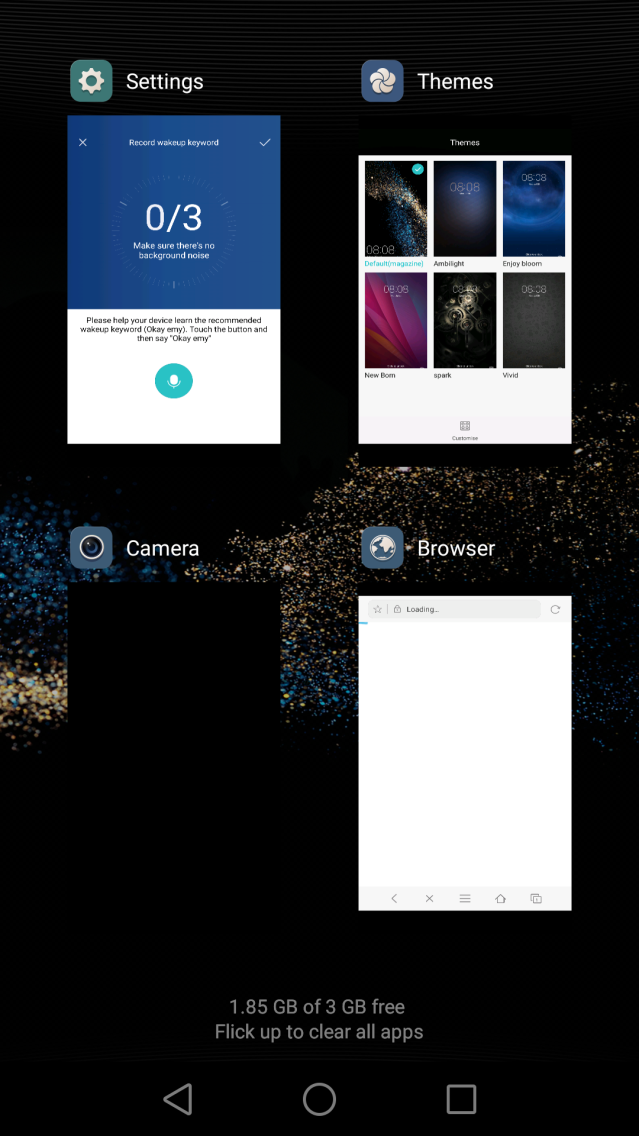
Huawei has also thrown in a whole host of new, but specific features. For example, it has an automatic international dialer that removes the hassle of remembering international country codes. There's a "Loud mode" for taking phone calls in noisy areas, and there's even a wind reduction feature for cutting down the sound of noisy wind interference on your phone call. As with many Android phones, Huawei has also added a themes feature where you can skin the entire UI.
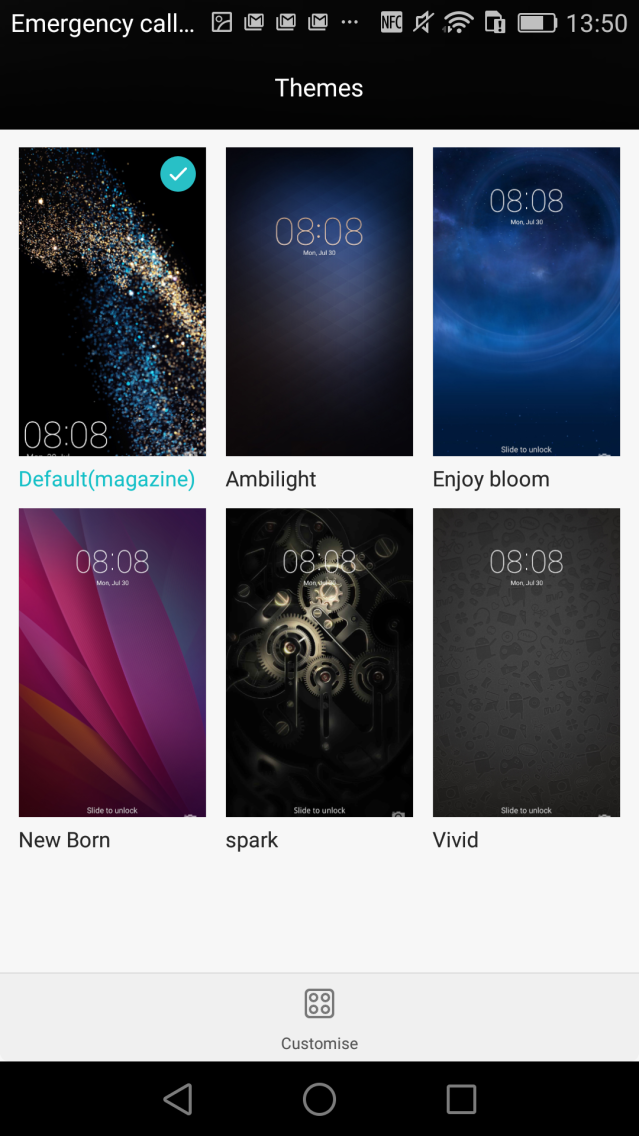
One feature that we can't quite get our heads around is the P8's Knuckle Sense feature. In theory, Huawei claims it has developed a new input system that can recognize the difference between your finger and your knuckle, thereby opening up new functions and input shortcuts. For example, double tap the screen with your knuckle and you can take a screenshot, or draw a rectangle with your knuckle to crop a picture. If that sounds awkward to use, it's because it is. It's definitely not something you can do one-handed and the recognition itself is somewhat a hit or miss affair. For example, it works when I use my thumb or middle finger knuckle, but not my index finger knuckle. Additionally, it occasionally thinks I'm using my knuckle when I'm actually using my finger and takes a screenshot I didn't want. At times, I wish I could turn it off entirely (after all, how often do you take screenshots), but unfortunately there doesn't seem to be an option for that.
The P8 also has a feature called Speech Awareness, which is somewhat similar to the Moto X's Moto Voice. You can say a phrase to wake your phone up and then issue it commands. For some reason the default phrase is "Okay emy," but you can change it to anything you like.
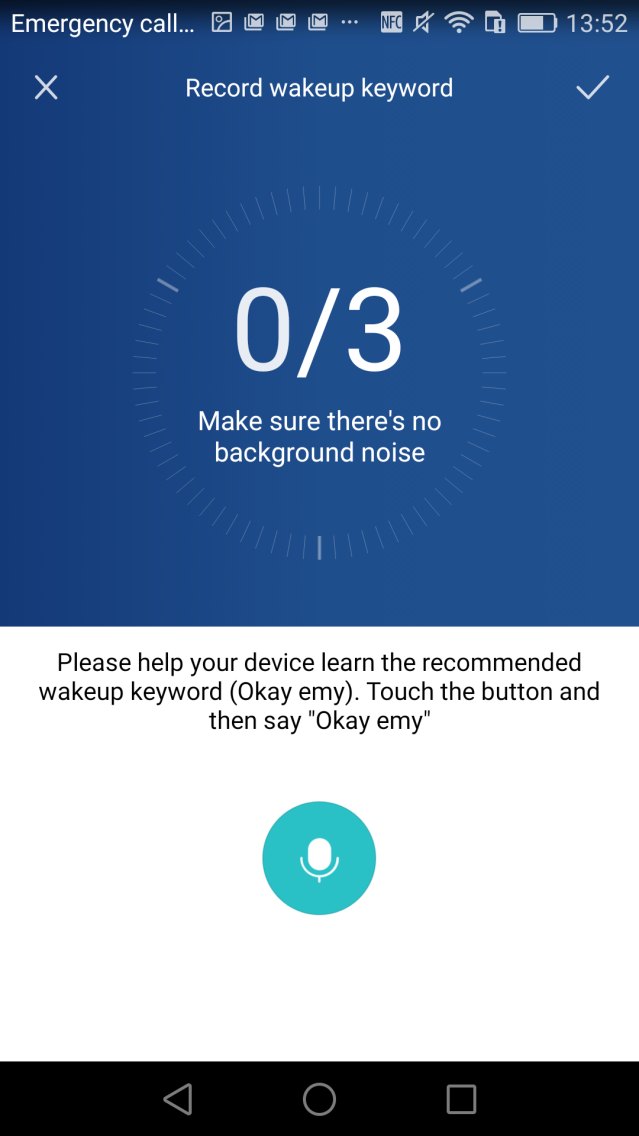
Another strangely implemented but actually quite useful feature is the P8's find my phone feature. By using the voice command "Hey, Buddy!" (mercifully, you can customize your own command), you can wake your phone up. Then just yell out "Where are you?" and it will cheerfully respond "Here I am!" It's not exactly "Her" but if you're anything like me and frequently misplace your phone, this feature is actually pretty handy.
Benchmark Performance
One of the drawbacks of last year's P7 was its underwhelming performance. Huawei is determined to correct that this year, and the P8 is armed with an octa-core Kirin 930 64-bit processor that Huawei says is 80 percent faster than the P7's Kirin 910.The Kirin 930, is based on ARM's big.LITTLE architecture, just like Qualcomm's octa-core Snapdragon 810 and Samsung's octa-core Exynos 7420. For the 930, it is made up of four Cortex-A53E cores at 2GHz and four Cortex-A53 cores clocked at 1.5GHz, which makes it slightly slower than both the 810 and 7420. Strangely enough, despite the fairly advanced processor, Huawei is using a Mali-T628 GPU from ARM, which was released way back in 2012.
For this review, we'll be comparing the P8 to the most recent flagship smartphone from each brand.
— |
|
|
|
|
— |
|
|
|
|
|
|
|
|
|
|
|
|
|
|
|
|
|
|
|
|
|
|
|
|
|
|
|
|
|
|
|
|
|
|
|
|
|
|
|
|
|
|
|
|
|
|
|
|
|
|
|
|
|
|
SunSpider Javascript
SunSpider Javascript helps measure the browsing performance of a device when processing Javascript. It not only takes into consideration the underlying hardware performance, but also assesses how optimized a particular platform is at delivering a high-speed web browsing experience. The P8 was the slowest competitor in this category, although its actual browsing performance wasn't that bad. There were some occasional stutters but for the most part the phone was quite responsive.

Quadrant
Quadrant is an Android benchmark that evaluates a device's CPU, memory, I/O and 3D graphics performance. The P8 didn't perform very well here and we suspect it was let down by its older GPU.

3DMark (2013)
Originally developed as a PC benchmarking tool, 3DMark is now expanded to support multiple platforms including Android OS. The Ice Storm benchmark is designed for smartphones, mobile devices and ARM architecture computers.
For an in-depth understanding of 3DMark for Android, do head over to our article, "3DMark - Android Device GPU Performance Review." In a nutshell, it is an OpenGL ES 2.0 benchmark test that uses fixed off-screen rendering to run two graphics tests designed to stress the GPU performance of your device and a physics test to stress its CPU performance. The benchmark consists of three test portfolios:- Standard (720p resolution rendering), Extreme (1080p resolution rendering with higher quality textures and post-processing effects) and Unlimited (disabled v-sync, display scaling and other OS factors that make it ideal for chipset comparison).
As all recent flagship smartphones have been maxing out the scores on the Standard and Extreme tests, we will only be looking at the scores for Ice Storm Unlimited.
Our suspicions have been confirmed as the P8's three-year-old Mali-T628 just wasn't competitive in this benchmark. In terms of real world experience, we also encountered a fair bit of stuttering while playing more intensive games on the P8.

Imaging Performance
The star feature of the P8 is its camera module, which commendably, is completely flush with the rear of the phone.
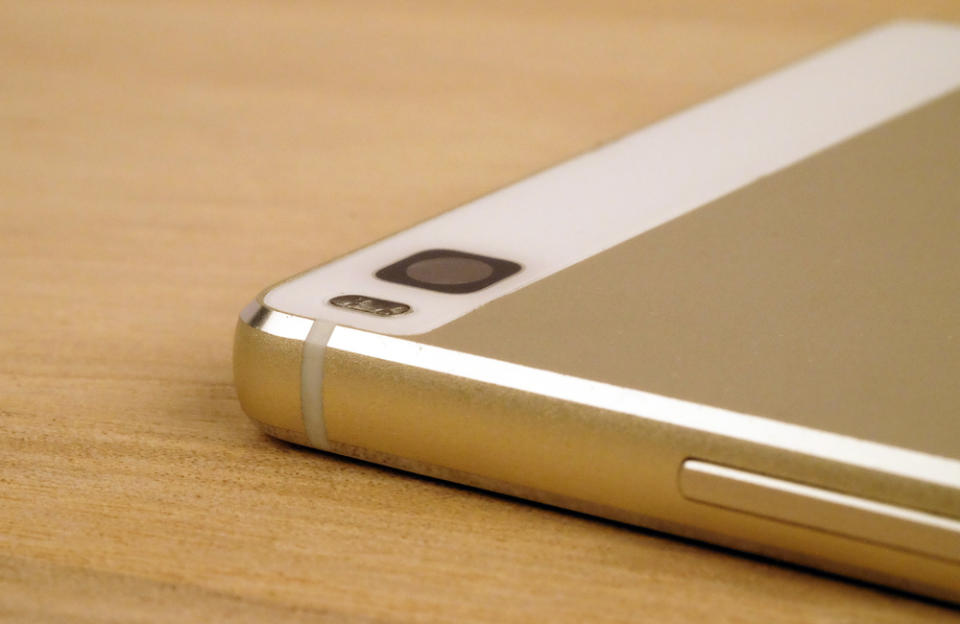
Huawei was quick to state at the P8 launch event that it's "not all about megapixels" and as such, the P8 has a fairly middling 13-megapixel shooter, but it is equipped with a number of innovative camera technologies that we have yet to see on any other smartphone camera.
First up is the P8's "best in class" optical image stabilisation, which is able to correct camera shake of up to 1.2 degrees. This should make the P8 significantly better better than the 0.6-degree correction provided by the Apple iPhone 6 Plus.
Next up, the P8 has the world's first four-color RGBW (red, blue, green and white) imaging sensor, with the claim that the camera will be able to more accurately capture a wider range of colors than traditional RGB sensors. Huawei says the extra white pixel also helps keep noise down in low light shots.
Finally, the P8 is armed with an independent image processor, just like you get in a DSLR, aimed at improving automatic scene recognition, providing more natural colors and more balanced exposure.
To complement its hardware, Huawei has loaded a number of interesting software functions into the P8's camera. A long-exposure "Light painting" mode lets you easily capture tail light streaks, star trails, light writing and flowing water, while the new "Director" mode lets you use your P8 to take control of up to three other Android smartphone cameras, and combine the video shot on them into one movie with multiple angles.
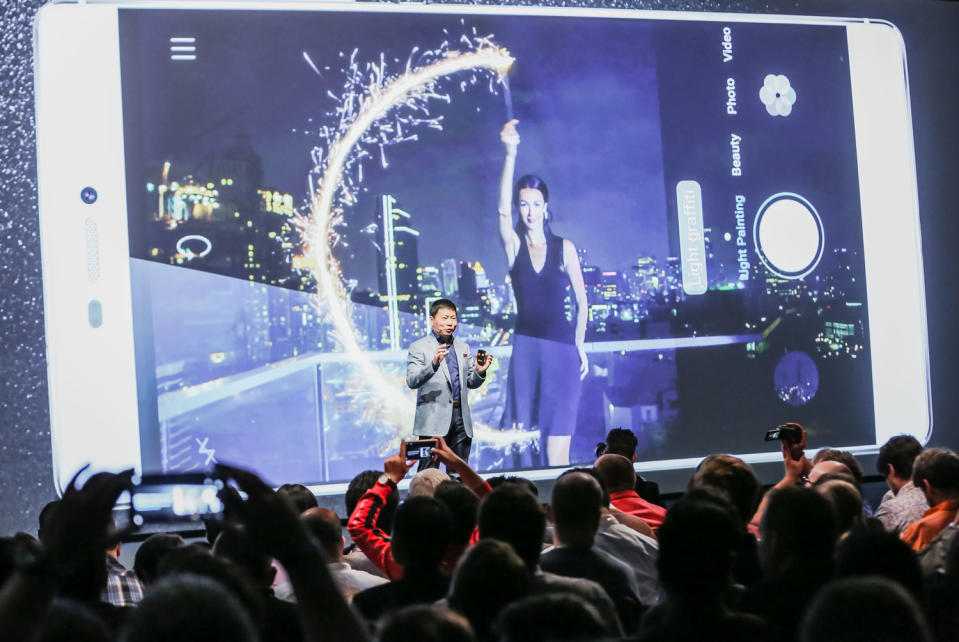
As for the camera app itself, it's fairly simple with some options for different shooting modes such as HDR and night scene. There's no manual mode but if you dig around in the settings deep enough, there's an option for adjusting exposure, brightness, color and contrast.
Like many smartphones, the volume keys can be used as a shutter button, and the camera will shoot in burst mode up to a maximum of 20 shots at a time by holding down either the on-screen shutter or volume key.
Image quality was a bit of a mixed bag. On the one hand, color reproduction was very good and, thanks to the optical image stabilization, images were quite sharp too. In good light the camera definitely performs well (see real world sample images below) but it struggles a bit indoors and is noticeably grainy in non-ideal lighting conditions.

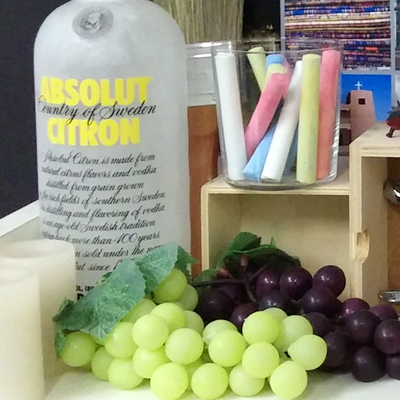 | 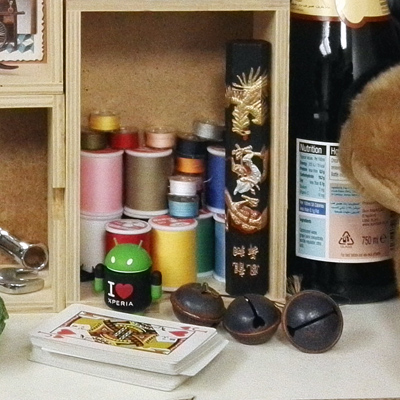 |
And here are some real world images taken with the P8.

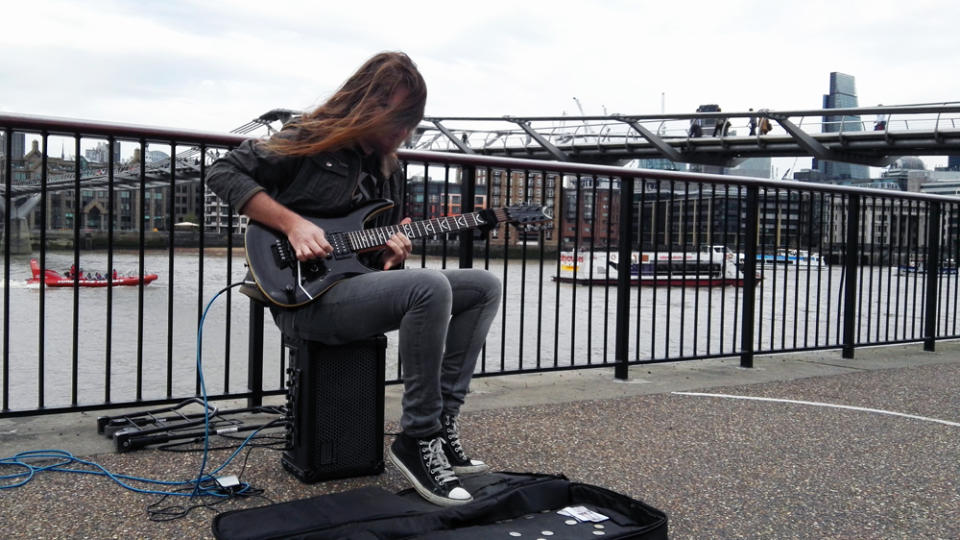
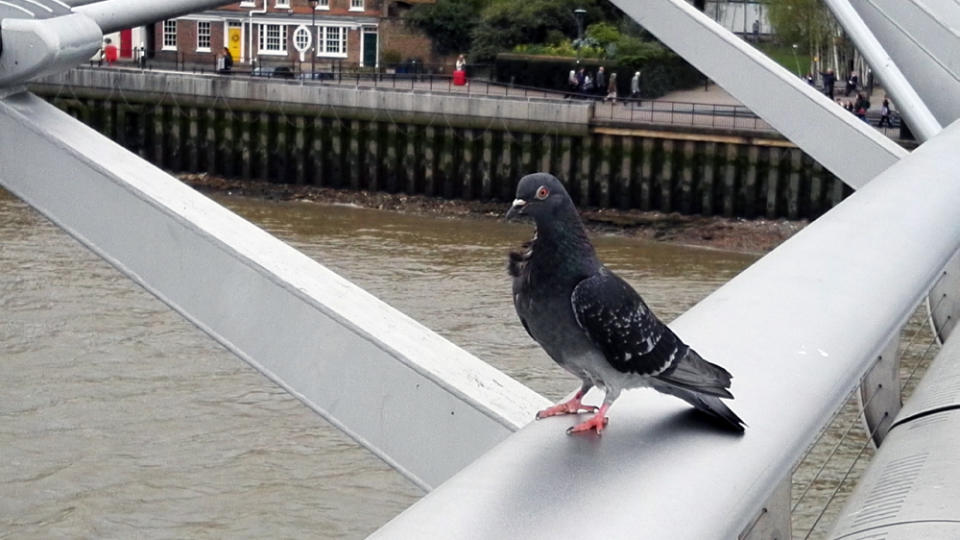
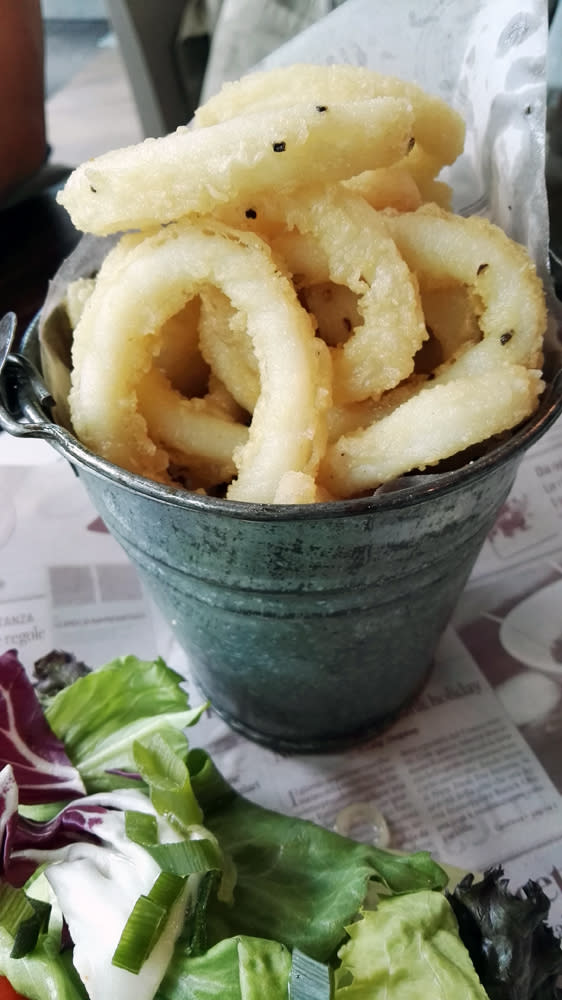
Battery Life
The P8 is powered by a non-removable 2,680mAh capacity battery, which is on par with the Samsung Galaxy S6 (2,550mah). However, Huawei claims that battery life on the P8 is much longer, and estimates about one and a half days of normal usage, thanks in part to technology like Huawei's "Power Consumption Firewall", which blocks 'abnormal' power usage from background apps.
Our standard battery test for mobile phones includes the following parameters:
Looping a 800 x 480-pixel video with screen brightness and volume at 100%
Wi-Fi and Bluetooth connectivity turned on
Constant data streaming through email and Twitter
Despite its decently-sized battery, the P8 was the worst performer in our video looping benchmark test, lasting just under seven and a half hours. It's worth noting that Huawei's Power Consumption Firewall feature wouldn't have much effect on our battery benchmark, and actual real world performance is likely to be somewhat better.
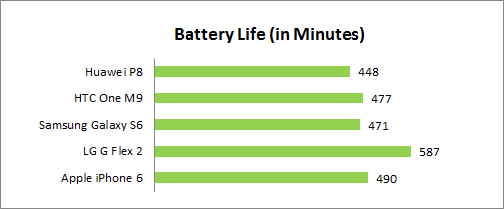
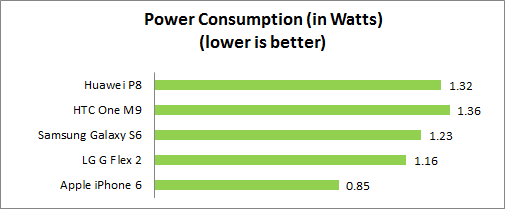
Portability
We measure the portability of a device by calculating its battery life to (weight x volume) ratio. Despite its lackluster battery life, the P8 actually scored quite well here thanks to its compact frame and thin profile.
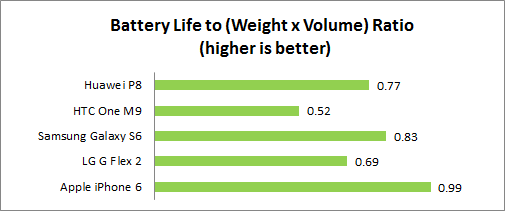
Conclusion
At €499 (~S$722), the Huawei P8 is affordable for a flagship smartphone. For that price you're getting a premium, slim and lightweight build, with a sharp 5.2-inch Full HD display and a decent camera that performs very well under the right conditions. However, the P8 is let down by its poor benchmark performance, and anyone that enjoys mobile gaming should look elsewhere.
For now, Huawei hasn't quite reached the level of flagship smartphones from some other brands, but we're glad to see that it continues its steady rate of improvement, and we commend some of the innovative features included in the P8 such as its 1.2-degree optical image stabilization and RGBW image sensor. If next year's P9 is armed with more competitive hardware, Huawei will definitely be one to watch out for.



